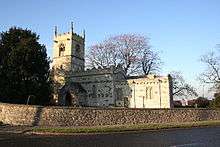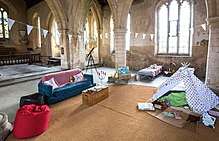Churches Conservation Trust
The Churches Conservation Trust is a registered UK charity (number 258612) whose purpose is to protect historic churches at risk in England.[1] In practice, the Trust works to prevent any deterioration in the condition of the buildings in its care and to ensure they are in use as community assets. Local communities are encouraged to use them for activities and events and the buildings provide an educational resource, allowing children and young people to study history, architecture and other subjects.
elevation.jpg)
The charity cares for 354 English churches of architectural, cultural and historic significance.[1] To date, 94% of the churches saved from closure are Grade I or Grade II listed.[2] Many are open to visitors as heritage sites on a daily basis and nearly 2 million people visit the Trust's churches each year.[2] The majority of the churches remain consecrated though they are not used for regular worship.
The charity is run by a board of trustees, nine individuals, who delegate the day-to-day management to a chief executive and the senior management team which includes five directors. Since 2017, the chief executive has been Peter Aiers.[3] The central office of The Churches Conservation Trust is located at Society Building, 8 All Saints Street, London, N1 9RL.
History
The trust was established by the Pastoral Measure of 1969[1] under its original name, the Redundant Churches Fund. The legally defined object of the trust is "the preservation, in the interests of the nation and the Church of England, of churches and parts of churches of historic and archaeological interest or architectural quality vested in the Fund ... together with their contents so vested".[4][5]

An earlier sister charity, the Friends of Friendless Churches, was founded in 1957. The Chairman, Ivor Bulmer-Thomas, later decided to support the establishment of the Redundant Churches Fund. The new charity's first project was the Grade I listed Medieval St Peter's Parish Church at Edlington in South Yorkshire in 1971.[6] It was virtually in ruins and was extensively restored.[7] By 1979, the trust was caring for 147 churches, increasing to over 250 by 2000, and eventually to 350.[8]
Finances
The trust is financed partly by the Department for Culture, Media and Sport and the Church Commissioners, but grants from those bodies were frozen in 2001, since when additional funding has come from other sources, including Sponsors and the general public. During the 2016-2017 period, the Trust's income was £9,184,283 and expenditures totaled £9,189,061. The income was down 18% down from the previous period because of the "reduced value of legacies and HLF Grants".[4]
The trust's Sponsors include the agencies listed above, while the Patrons are Stephen Dawson, Tom Peers, Debbie Dance MSc MRICS FRSA, Christopher Knight and Janet Townsend-Stojic. The chief Donors are Ned & Neva Asplundh, Michael Fowle, Timothy Ingram Hill and Richard Taylor.[2]
During 2016–2017, 92% of the expenditures went to front line projects, with 65% of that spent on church repairs and maintenance. Most of the balance was spent on efforts to keep churches open by increased tourism, volunteering and partnership programmes.[2] During that year it had 64 employees, and received the support of up to 2,000 volunteers.[9]
Lists of churches maintained

Northern England
This list contains the churches in the counties of Cheshire, Cumbria, Greater Manchester, Lancashire, Merseyside, Northumberland, Tyne and Wear and Yorkshire.
East of England
This list contains the churches in the counties of Bedfordshire, Cambridgeshire, Essex, Hertfordshire, Lincolnshire, Norfolk, and Suffolk.
English Midlands
This list contains the churches in the counties of Derbyshire, Gloucestershire, Herefordshire, Leicestershire, Northamptonshire, Nottinghamshire, Rutland, Shropshire, Staffordshire, Warwickshire and Worcestershire.
South East England
This list contains the churches in the counties of Berkshire, Buckinghamshire, East Sussex, Greater London, Hampshire, Kent, Oxfordshire, Surrey and West Sussex.
Camping

The Churches Conservation Trust organise camping in churches (or champing) for the churches in their care to provide accommodation for campers as a form of fund-raising.[10][11][12][13][14]
References
- About us, Churches Conservation Trust, archived from the original on 16 August 2013, retrieved 1 April 2011
- What We Do: About us: Our Annual Review visitchurches.org.uk, accessed 28 December 2018
- Who we are, Churches Conservation Trust, retrieved 2 July 2018
- What We Do: About us: Annual Report & Accounts visitchurches.org.uk, accessed 28 December 2018
- Pastoral Measure 1983:Section 44(4), National Archives, 1983, retrieved 2 September 2015 (Pastoral Measure 1983 consolidates Pastoral Measure 1968 with later legislation.)
- Google streetview entry for St Peter's Church, Edlington google.ca/maps, accessed 28 December 2018
- "Old Edlington St Peter". Archived from the original on 2018-07-02. Retrieved 2018-07-02.
- What We Do: About us: Our History visitchurches.org.uk, accessed 28 December 2018
- Churches Conservation Trust Annual Report, 2016/2017, Charity Commission for England and Wales, retrieved 2 July 2018
- Ough, Tom (29 January 2017), "Camping in a church seemed like a great idea – until we locked ourselves out", Daily Telegraph
- Dixon, Rachel (29 May 2015), "Holy nights: camping in a church", The Guardian, ISSN 0261-3077
- "Church camping", The Churches Conservation Trust, 2017, archived from the original on 22 June 2017
- Mills, Emma (9 June 2015), "Churches the new Airbnb as 'champing' proves popular", Daily Telegraph
- "The medieval churches you can camp in", The Travel Show, BBC, 25 February 2017